

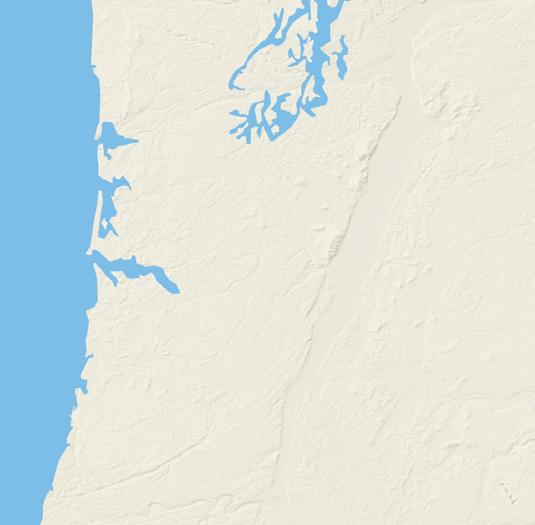






September 2024 • Volume 72, No. 9
CEO Michael Shepard
SENIOR VP OF CONTENT Leon Espinoza
EDITORIAL DIRECTOR Mike Teegarden, CCC
DEPUTY EDITORIAL DIRECTOR
Noble Sprayberry
SENIOR EDITOR Jennifer Paton, CCC
ASSISTANT EDITORS Chasity Anderson, CCC; Victoria Hampton, CCC; David Herder, CCC
ASSOCIATE EDITORS
Valeri Pearon, Nina Todea
PUBLICATIONS PRODUCTION SR. MANAGER
Elizabeth Beatty
SENIOR PUBLICATIONS COORDINATOR
Alyssa McDougle
Ruralite (USPS 397-460) is published monthly for members for $4.83 per year, plus postage, by Pioneer Utility Resources Inc., 5625 NE Elam Young Pkwy. Ste. 100, Hillsboro, OR 97124—a not-for-profit Oregon cooperative corporation—to serve the communication needs of 46 consumer-owned electric utilities in Oregon, Washington, Alaska, Idaho, Nevada and California. Preferred periodical postage paid at Hillsboro, Oregon, 97123 and additional mailing offices. © 2024 Pioneer Utility Resources. All rights reserved. Reproduction in whole or in part without written permission is prohibited.
Postmaster: Send address changes to Ruralite, 5625 NE Elam Young Pkwy. Ste. 100, Hillsboro, OR 97124-6454
HOW TO CONTACT RURALITE
Subscription services:
Nonmember subscriptions $15 (U.S.) per year; $25 per year (foreign). Prepayment required. Allow 4-8 weeks for first issue. Be sure to identify which local edition you want to receive.
Address Changes:
Utility members, contact your local utility. Subscribers, call us at 503-357-2105 option 3 or email mailingdept@pioneer.coop.
Back issues:
Back issues and extra copies $3. Prepayment required. Supply is limited. Be sure to identify edition, month and year. Call first if ordering back issues to check availability.
To contact Ruralite: Ruralite magazine is published by Pioneer Utility Resources.
P.O. Box 1306, North Plains, OR 97133-1306; 503-357-2105; email: info@pioneer.coop. For more information, visit www.pioneer.coop.
DISPLAY ADVERTISING INQUIRIES
American MainStreet Publications
611 S. Congress Ave., Ste. 504 Austin, TX 78704
800-626-1181 or 512-441-5200
While I live in the suburbs now, I grew up on a country farm until I was about 12 years old. I understand what life away from common services and conveniences is like.
I had few neighbors as a child and even fewer with children my age. I spent a lot of my youth roaming our 50 acres with my dog, catching salamanders, feeding sheep and riding my bike. I became adept at entertaining myself.

Two stories this month highlight different aspects of rural living and the effort required to overcome obstacles.
Our Spotlight feature on Page 12 looks at how two rural high school athletes successfully raised their profiles to attract interest from college programs. Success wasn’t easy or instant. It took dedication and hard work to accomplish—something rural athletes know a lot about.
The Up Close feature on Page 10 takes us to
a small, remote Alaskan village, where harsh elements make having a solid home a matter of survival.
One organization designed a new energyefficient home that is expandable and adjusts as the foundation shifts due to temperature changes. So far, six of these homes have been built. The villagers who live in them save significant money on their heating bills thanks to the efficiencies of the new construction. They also are more comfortable and have room to process and store the fish and game they harvest to feed their families.
More homes are planned as funding becomes available.
I want to thank the many readers who entered our calendar photo contest this year. As always, choosing the winners is a challenge. Congratulations to the winners. Visit ruralite.com/2025-calendar-winners to see the winning photos.
Mike Teegarden Editorial Director

For supplemental and interactive content, search @Ruralite on your favorite social media sites.
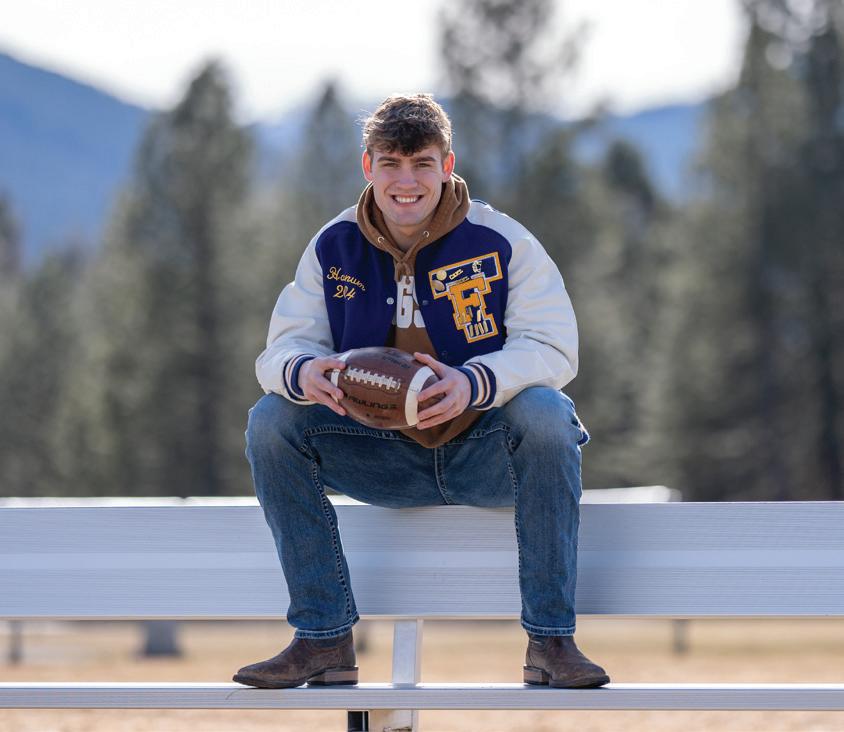
New energy-efficient design changing lives in small community Up Close, Page 10
Rural athletes overcome hurdles to win scholarships Spotlight, Page 12 Let’s Get Prepared 4 In the Kitchen 16
4-8, 25, 28-29, 32

1 PREPARE: Do you have an outage kit? The list to the right is an example of what you should have on hand to stay safe during an outage.
2 BE INFORMED: When your power goes out, our outage map is instantly updated with the location of the outage, the number of members who are affected and when crews are assigned to respond. The map can be found at outage.gvea.com. It’s your quickest and best resource to stay informed during an outage.
3 CONNECT: Do we have your current contact information? You can update your information directly through your MyGVEA account or submit a form at www.gvea.com/account-maintenance-form. Don’t have a MyGVEA account yet? Register today! Visit www.gvea.com/MyGVEA to set up your account.
4 POWER DOWN: Turn off and unplug sensitive equipment, such televisions and gaming consoles. Equipment with motors, such as refrigerators and furnaces, should also be turned off. Once the power has been restored and stabilized, you may safely turn on power to these items.
Now that you’re ready, relax.
Oh, wait! Your power goes out, and as soon as this happens you’d like to know for how long. We understand. The No. 1 question we hear is, “How long will my power be out?” We get it. Unfortunately, repair times are difficult to predict due to the many variables, including type of damage, weather and availability of parts. When your power goes out, crews are immediately dispatched to troubleshoot and repair outages. They safely work to restore power as quickly as possible, but it takes time. Visit our outage center at www.gvea.com/outages for all of this information and more.
Because we live in an extreme climate, it’s a good idea to keep an emergency outage kit on hand.
Water – 1 gallon/person/day
First-aid kit, freshly stocked
Nonperishable food
Flashlights and extra batteries
Portable cell phone chargers
Battery-powered radio with access to National Oceanic and Atmospheric Administration weather alerts
Copies of important documents (identification, insurance policies, etc.)
Emergency contact information
Cash
Multipurpose tool
Blankets and sleeping bags
Food and water for pets
Change of clothing
Books, board games, puzzles, etc.
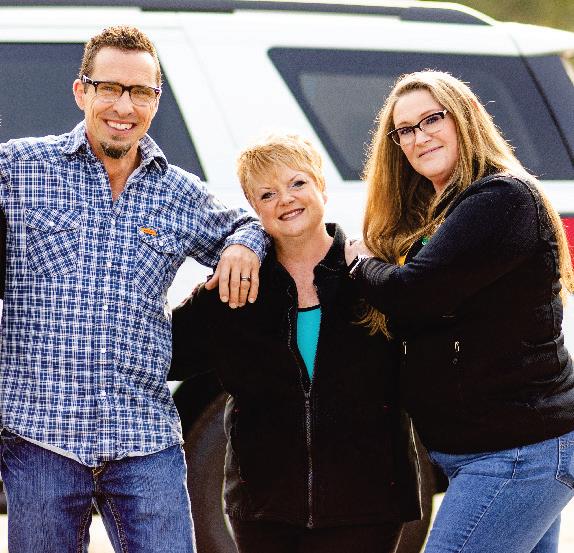

Safety is always on the minds of the Golden Valley Electric Association Safety Team— even after hours. With winter approaching, each safety specialist offered a few tips for members.
Safety Tips
• Clean your chimney.
• Install and/or check smoke detectors and/or carbon monoxide detectors.
• Make sure your boiler is in top operating condition.
• There is plenty of daylight now, but the cold and darkness of winter is swiftly approaching. Recharge lanterns and make sure you have batteries for flashlights. Keep a headlamp handy.
• Test your generator to make sure it is in tip-top shape, in case you need to use it. Generators can produce deadly levels of carbon monoxide, so never operate it inside the home or garage.
• Check heat tape and extension cords for safe wiring.
• Keep driveways clear so GVEA workers can easily access your property.
• Heavy snowfall can cause electric lines to sag and sometimes even fall to the ground. Adults and children should stay away from all electric lines. Never touch them.
• Buy a car charger for your mobile phone. If power goes out, you can charge your phone in the car.
• Keep spikes handy to wear on shoes/boots during icy days.
• Keep a safety kit in your vehicle that includes a sleeping bag or blanket.
• In the event of an electric outage this winter, have things for children to do inside, including coloring books, reading books, etc.
By Kelly Reynolds


Whether you’re hiking to find the best spot for blueberries or packing your bags for a fall hunting trip, venturing into the backcountry for harvest and hunting season is an Alaskan tradition that requires preparation. From ensuring you have adequate food supplies to being physically fit and well-equipped, each aspect of preparation is crucial for a safe and successful trip. Here’s a comprehensive guide to help you prepare for your Alaska adventure.
last thing you want is to be stuck in the wilderness with food you can’t stomach.
Always carry extra food supplies to cover unexpected delays. A general rule of thumb is to bring an additional two days’ worth of food. This ensures you’re prepared for any unforeseen circumstances.
Maintaining your energy levels during any type of backcountry activity is critical. Your food should meet your calorie, protein, fat and carbohydrate needs based on your activity level. A wellbalanced diet helps sustain your energy and performance levels throughout your trip.

When planning for a backcountry trip, ensuring you have the right food supplies is paramount. Opt for nutrient-dense, nonperishable foods that are easy to carry and prepare. Freeze-dried meals, highcalorie energy bars, nuts, seeds, dried fruits, jerky and instant oatmeal are excellent choices. These foods are lightweight, pack a nutritional punch and require minimal preparation. It’s essential to test your food choices before embarking on any kind of trip. A backwoods trip without amenities, such as, running water and toilets, may not be the best time to try a new brand of dehydrated meals. This helps you determine if you enjoy the taste and if they agree with your digestive system. The
Hydration and access to clean water are critical components of any backcountry adventure, especially in the rugged terrain of Alaska. Staying properly hydrated helps maintain physical performance, cognitive function and overall health, reducing the risk of fatigue, heat exhaustion and other dehydration-related issues. Clean water is essential to prevent waterborne illnesses that can quickly derail a trip. Carrying a reliable water filtration system or purification tablets ensures you have a safe and continuous supply of drinking water, allowing you to stay hydrated and healthy throughout your journey. Again, it’s important you know how to use your water filtration system before you hit the trails.
If you require medication, ensure you have enough to last the duration of your trip, plus extra in case of delays. Consider keeping your medications in waterproof containers and store them in an easily accessible part of your pack. Additionally, let your adventure partner know what medication you’re taking, where to
find it within your gear and what to do in the event you have a medical emergency.
A comprehensive first-aid kit is a nonnegotiable item for any backcountry trip. The size of your kit may vary depending on your mission. If you’re fourwheeling in the mountains looking for berries or taking boats to hunt moose, you have the capacity to carry a larger, more comprehensive first-aid kit. If you are backpacking and counting every ounce, you may want to consider what is necessary to take. Knowing how to use each item in your kit is equally important. Consider taking a basic first-aid course if you’re not already familiar with these procedures.
Being physically fit is essential for the rigorous demands of most Alaskan backcountry activities. Your fitness regimen should include cardiovascular exercises, strength training and flexibility exercises. Hiking with a loaded backpack can help your body become adjusted to the weight, while building up the strength and endurance for your upcoming trip. If you are adventuring with a partner, ensure you are both familiar with each other’s physical limitations and expectations before you leave.
Wearing the right clothing is crucial for comfort and safety. Layering is the key to staying warm and dry. Start with a moisture-wicking base layer, add an insulating layer like fleece or down, and top it off with a waterproof and windproof outer layer. Avoid cotton, as it retains moisture and loses insulating properties when wet. Cotton is also known to retain body odor, which your adventure partner may appreciate you avoiding.
Before heading out, ensure your clothing fits well and is comfortable for extended wear. Break in your boots to prevent blisters and test your layers to ensure they work well together. Comfort is crucial to maintaining your physical and mental wellbeing during your trip.
Remember, you don’t have to purchase the most expensive gear on the market to have fun and stay dry and warm. Ask those in your adventure circle for their gear recommendations.
Having the right gear is essential for a successful backcountry trip. This includes a dry bag or backpack, a reliable tent or shelter, a sleeping bag rated for the temperatures you’ll encounter, a sleeping pad, a stove and fuel, lighter cooking utensils, a water filtration system, navigation tools
(map, compass and GPS), a headlamp with extra batteries and bear protection. Consider wrapping your water bottle or hiking poles with electrical tape or rope, strap your GPS to your chest and keep snacks and water in an easily accessible place in your pack along with your fire starter and signaling devices. These items can be lifesaving and should be easy to reach in the event you or your partner is injured.
Before embarking on your trip, create a detailed plan. Outline your route, estimated travel times, campsite locations and contingency plans for potential hazards. Share this plan with a trusted person who will be staying at home or within cell service. Provide them with your itinerary, expected check-in times and emergency contacts. Regularly check in with them via satellite messenger or cellphone when you have service. This ensures someone knows your whereabouts and can alert authorities if you don’t return as scheduled. You both should be on the same page about where you’re going, how long you’re going, how often you’ll check in, when to become worried if there’s a lack of communication and who to contact if there’s an emergency. Remember, you should communicate a plan with someone even if you’re only doing a short trip. It doesn’t matter if your trip is two hours or two weeks long, having a plan with someone you trust could save your life.
Preparing for hunting and harvest season in Alaska involves careful planning and attention to detail. Ensuring you have the right food, medical supplies, physical fitness, proper attire and equipment, along with a solid plan and clear communication, are critical components for a safe and enjoyable adventure. By taking these steps, you’ll be prepared to face the challenges of the Alaskan wilderness and make the most of your backcountry experience. n

By Rachael Kvapil
Mike Reynolds, GVEA’s relay technician, already had an established career as an electrician in Fairbanks when he applied for his position in 2021. After 10 years primarily in the construction field, he was interested in transitioning into the utility industry. Now he’s part of a team that ensures electricity is distributed safely and reliably to homes and businesses in the Interior.
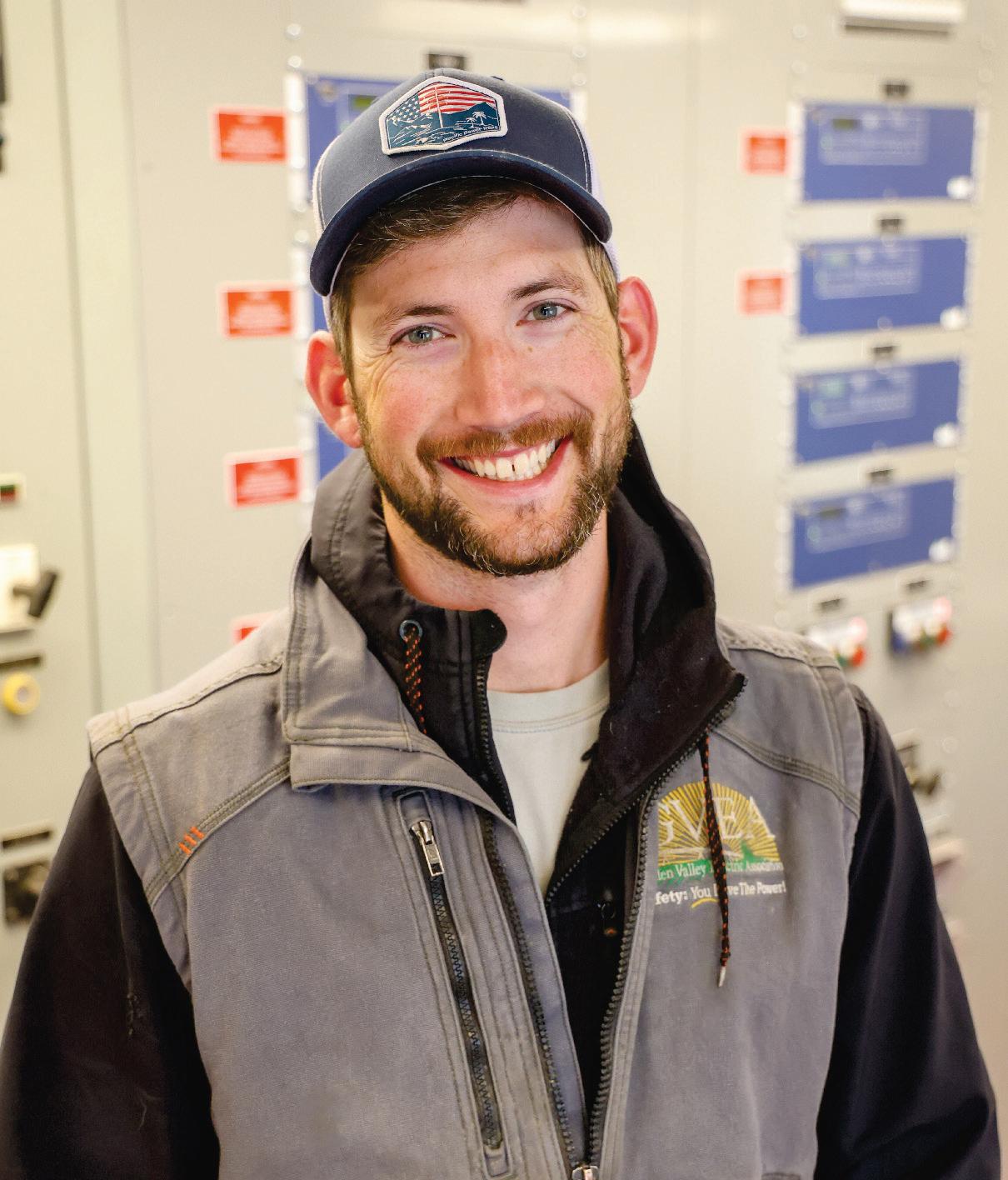
As a relay technician, Mike works with a crew to conduct protective relay testing and maintenance on substations within the Interior. They are also responsible for anything involving line and distribution protection. By using advanced technology to monitor systems and breakeroperated controls, they are able to identify transmission problems and respond appropriately.
“For instance, if a tree falls on a line, we run the equipment that senses the down line and allows us to deenergize it,” Mike says.
Monitoring and maintaining systems requires significant travel, up to 100 miles from Fairbanks in any direction. Mike enjoys the remote locations and various weather conditions of the job. Every day is different. When storms hit, relay technicians are often called on to assist with outages.
Mike says the best part is working with his crew to troubleshoot problems. Although his career as a relay technician is similar to his work as an electrician, he explains that the objectives are different. In his previous
job, he spent more time constructing the electrical system for a building. As a relay technician, he works more with electrical theory and spends less time bending pipe and pulling wire.
“It’s like a whole other trade,” Mike says. “My years as an electrician really provided a solid electrical knowledge base that I apply more in theory in my current work.”
He says anyone interested in working at a utility should join an apprenticeship early and learn about all the different parts of a trade. By focusing on the aspects of the trade that spark a real interest, he says, it will become easier to identify positions that match those interests.
Mike was born and raised in rural Upstate New York. After his father moved to Alaska to run sled dogs, he traveled between the two states until 2008, when he moved to Fairbanks permanently to complete high school and start his electrician apprenticeship. He loves living, working and recreating in Alaska. He enjoys spending as much time as he can outdoors boating, fishing and hunting with family and friends. n























By Molly Rettig
Alex Beans grew up on the Lower Yukon River, a network of southwest Alaska streams, ponds and coastal wetlands so vast it’s larger than Pennsylvania. His house, however, was small and crowded.
“We had 10-plus people in the house most of the time,” Alex says. “I slept on the couch for most of my childhood with my mom.”
In Mountain Village, Alaska—a Yup’ik community of roughly 700 people—more than a third of the families live with similar crowding. The same is true across more than 200 rural Alaska communities.
But size isn’t the only problem. Mainly built by federal agencies in the 1970s, these homes were not designed for the Arctic conditions—temperatures that reach 60 below and wind that can blow off roofs. The homes are cold, moldy and costly to heat.
Richard John Queenie lives in a house about the size of a single car. The foundation is so old and saggy that the walls are pulling away from the floor.
“The logs are disintegrating, just rotting away under there,” he says.
With no indoor plumbing and little insulation, Richard keeps two space heaters running nonstop in the winter.
“I go through more than 20 gallons of stove oil every two weeks, and another $322 for the electric heater over there,” he says.
That’s around $700 a month just for heat. While Richard has a good job working as a carpenter for the tribe, he can’t afford to build a new home—even the 24-by-26-foot house he’s thought of building himself.
It gets worse. Because of climate change, the region

is warming three times faster than the rest of the planet. The permafrost underlying Mountain Village is thawing and slumping in some places, freezing and heaving in others. Older homes elevated on posts—a strategy to avoid disrupting the permafrost—are tilting and shaking.
These housing issues, combined with the recent crash of the salmon fishery on the Yukon River, have prompted many to leave the region. That’s why Alex and the Asa’carsarmiut Tribe are building new efficient homes to withstand the harsh climate.
Through a partnership with the National Renewable Energy
Laboratory’s Alaska Campus, in 2022 the tribe built five homes in Mountain Village. The homes get residents off floors and couches while keeping them on their traditional lands.
Another home is being built in 2024. Future homes may be added as funding becomes available.
The Yup’ik people have occupied the region for thousands of years and are experts of the land. They worked with NREL researchers to ensure new housing incorporated traditional wisdom with the latest science and technology.
Because the homes were funded to help people transition out of homelessness and stay safe during the COVID-19 pandemic, the original goal was to keep the homes small and build as many as possible. Community members wanted them to be energy efficient.
“The homes are very well-insulated,”

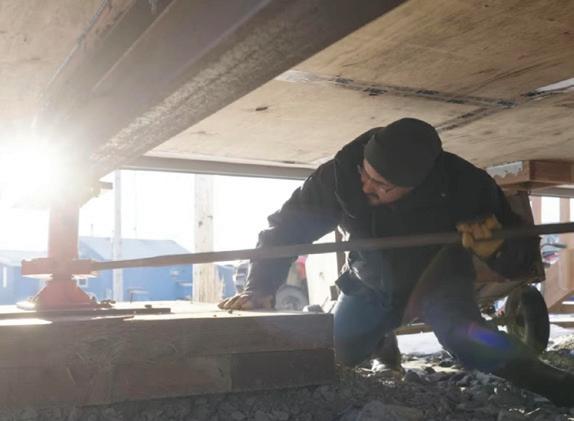
Alex says. “There’s just a small heater to heat the home, and on the extended versions, we have a woodstove. If we have the woodstove going, there should be almost no cost going to heating fuel.”
Residents also wanted room in the new homes to process and store subsistence foods. So, while the homes are small, NREL designers included extra-large foundations and decks, which also make it easier to add on to the living space over time.
“One of the key things we’ve learned from people who live in tiny houses is they’re great for a certain time and then you want them to be bigger,” NREL architect Aaron Cooke says. “We designed not a house but a house that could be expanded in three different ways. If you move into a small version of the home, which is about 380 square feet, you have the freedom to expand, whether it be an entryway, an arctic entryway or another bedroom.”
Local people not only helped design the homes, but they built them, too.
“Everything that was put into the homes created jobs out here and allowed our people to have actual job

experience and learn more about the new science we can put into homes that will benefit people in a cold climate,” Alex says.
The designs are a blueprint for future building, and the workforce training gives local people tools to address their housing shortage.
Aaron says two characteristics make foundation design difficult: The ground is frozen, but it is also thawing at an unpredictable rate.
“We had to design a foundation that could handle frozen soils and can also adjust as these soils change,” Aaron says.
Steel beams under the floors rest on adjustable jacks, which sit on treated wood footers. In January, Alex crawled under a home with a level, measured the beams and then used a steel bar to adjust the jacks and level the house.
Afterward, he ducked his head inside to see Agnes Brown, 78, who had recently moved into the house. Though it was below zero outside and dropping, Agnes was in a T-shirt.
“It’s nice and warm, and the fuel is so much lower than my old house, “she says. “I’m so grateful, very grateful.” n
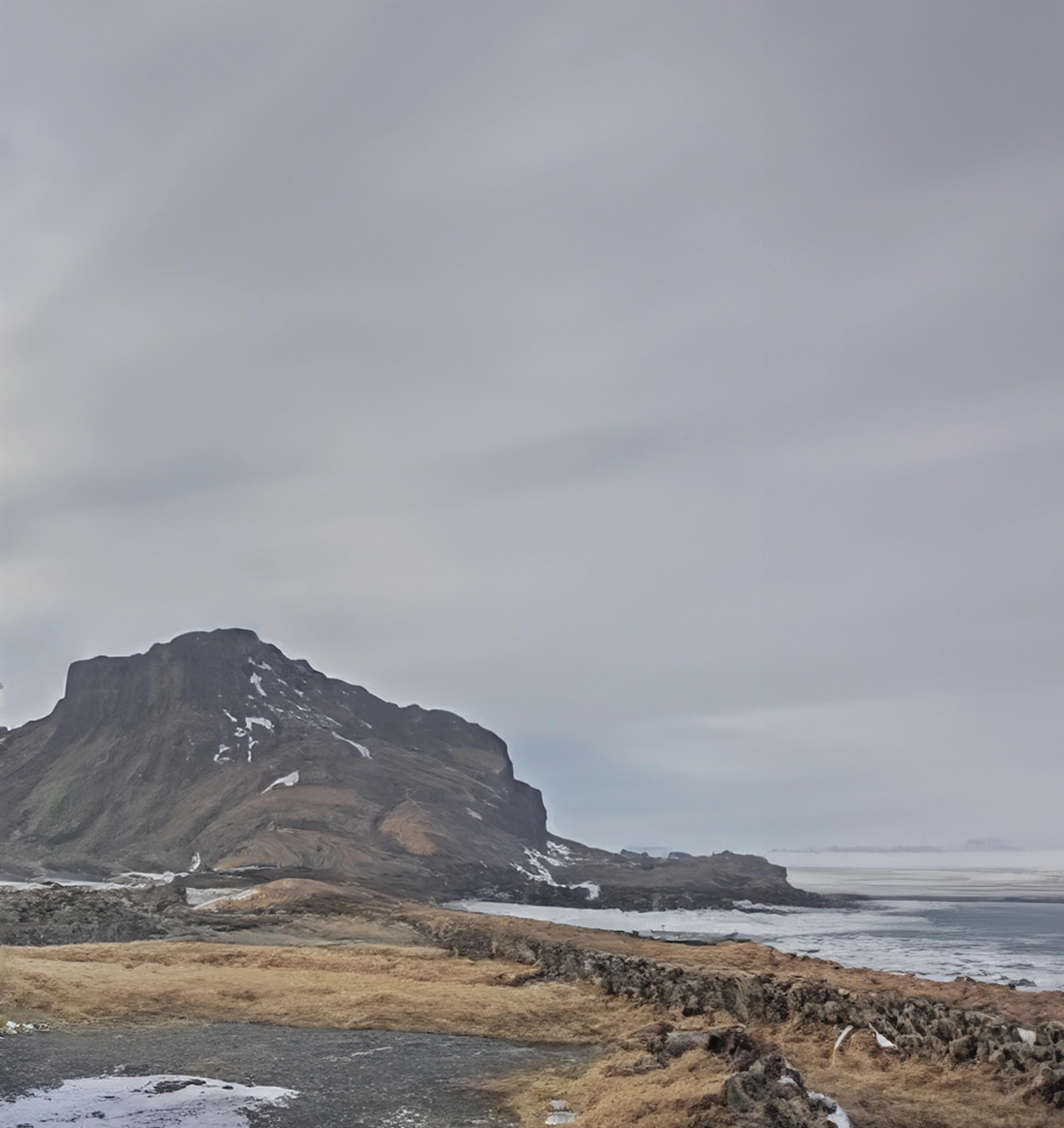
By David Herder
Dannika Goss has always wanted to play collegiate volleyball. Life put many challenges along her way to that goal. She honed her vision, reactions and other skills to fulfill her athletic potential. She also put in thousands of miles of drive time, traveling more than an hour from her rural home along the Oregon Coast in Tillamook to practice and play with her club volleyball team in Salem. She spent her high school years attending camps and tournaments where she was one of hundreds of athletes evaluated by college coaches.
Each year, thousands of studentathletes across the country pursue college scholarships. Ultimately, only 1 of every 50 is likely to reach that level, according to a 2021 study by Next College Student Athlete. That bar can be even tougher to clear for athletes like Dannika, who live in rural areas where getting the attention of major programs can be more difficult.
For rural athletes like Dannika, winning a spot on a college roster takes more than just the talent and commitment to be a high-level athlete—it also takes a second job as a communicator and organizer, working just to be seen.
Dannika, a member of the Tillamook High School class of 2024, started playing volleyball in kindergarten. In fourth grade, she was excited because the players were now old enough to use a full-sized volleyball, and she joined the local club team, Tillamook Volleyball Club.
Club sports can be important to athletes’ development. School teams play in the fall, winter or spring, but club teams keep athletes in shape and improving throughout the year. Beyond gym and coaching access, clubs can also
switched to play with North Pacific Juniors, a club based in Salem, Oregon. That NPJ coaching staff included Haley Domeck, who is now the head coach at Linfield University, a Division III school in McMinnville, Oregon. While Haley coached the age group above Dannika’s at NPJ, she watched Dannika improve.
“She is one of the nicest human beings I have ever met in my entire life,” Haley says. “Coming from Tillamook to Salem was no small commitment on her end or her family’s end.”
Haley, who played volleyball at Hawaii Pacific University and graduated in 2015, says playing club sports is a great way to improve and get noticed.
“It’s not about what club you play for, it’s more so about getting touches on the volleyball,” she says.

These touches don’t necessarily have to come from club sports, but it’s important for athletes’ growth to be in the gym working on conditioning or finding other ways to play and improve.
When playing at the club level, an

I was just doing multiple things as much as I possibly could to get my name out there, because I am from a very small town here in Tillamook.
— Dannika Goss, college volleyball player
advantage beyond practice is traveling to large tournaments. In her role as Linfield coach, Haley often attends these tournaments to scout talent. While sports like track or swimming can recruit athletes based on their times, and some more dynamic sports like baseball can recruit pitchers based on measurables like pitch speed and ball rotation, volleyball is more difficult to measure and requires the eye test.
“One of my rules as a coach is I have to see somebody play live in order to make them an offer,” Haley says, “because there’s things that you pick up on in person that you don’t see on film.”
Club tournaments can be large. There can be 200 courts running with four teams


per court and 12 athletes per team. With thousands of athletes competing at once, these tournaments help coaches maximize the number of players they can see.
“It’s quite a recruiting beast,” Haley says.
Not every sport has clubs helping athletes improve during the high school offseason, but most sports have camps and showcases that help recruits get seen by coaches. Max Hannum, a football player in the class of 2024 from Thompson Falls, Montana, took part in camps operated by college teams from around the state. Typically, he’d travel two to four hours each way.
knowledge and more drills he could use throughout the year to improve. The camps also let him get to know the coaches, and the coaches got to know him.
Persistence pays off
Max wasn’t only meeting coaches in person at the camps—he often reached out electronically, too. The internet helps make
sent him game film to review through a website called Hudl. Operating somewhat like a sports version of YouTube, Hudl is a website and app where teams and athletes post game film and highlights. While reviewing his team’s film, Max would highlight his best plays and edit his own highlight reel. He’d then share the highlights on Twitter or send them directly to coaches.
I felt like all the work I put in finally paid off. Getting your name out there is the biggest thing.
— Max Hannum, football player from Thompson Falls, Montana
“I had to travel a lot for those camps,” he says. “Going to the camps is really the only extra football you can do around here.”
Max says these camps made a huge impact on his football career. Working with coaches, he took his techniques as a tight end and linebacker to a higher level. He says collegiate coaches had extra
the world smaller, and sharing highlight tapes allows rural athletes like Max and Dannika to be seen by coaches who don’t have the time to travel to see them play. This skill of sharing one’s story has helped many athletes find homes on college rosters.
“Getting your name out there is the biggest thing,” Max says.
During football season, Max’s coaches
“My approach was just to send my highlight films everywhere, trying to get in contact with as many coaches as I could,” he says.
While that shotgun approach could have lead to more rejections from coaches, that didn’t bother Max.
“It motivated me at the same time just to get better,” he says.

Even as a coach whose email inbox can get stuffed with messages from recruits, Haley agrees that athletes should reach out to coaches they’d like to play for. If an athlete doesn’t hear back, they should be persistent.
“It’s not fun hearing no, but at least you know where you stand,” she says. “If you are, for lack of a better term, annoying, or if you’re persistent, we’re going to respond to you at some point. There’s lots of things going on.”
Fulfilling the dream
Dannika tried many methods to get recruited. She attended showcases at colleges and the one hosted by her club team. She also used an app called SportsRecruits, which connects recruits and coaches and lets athletes post videos and highlights for coaches to scout.
“I was just doing multiple things as much as I possibly could to get my name out there, because I am from a very small town here in Tillamook,” Dannika says.
Max’s moonlighting as a video editor helped keep him in contact with coaches. After narrowing the list down to fit with his academic pursuits—he intends to study construction management, with an eye on the energy industry—the staff he was in the heaviest conversation with was at Montana Technological University in Butte, Montana. This fall, when he was attending the school’s football camp, the Montana Tech coaches offered him a scholarship.
“I felt like all the work I put in finally paid off,” Max says. “I’ve always wanted to be a collegiate football player. That’s always been my dream. I grew up with a bunch of friends that had this same goal, and not a lot of them reached it.”
For Dannika, being recruited by multiple schools was fun but also stressful.
“I didn’t want to let any of the coaches down or anything, because I wasn’t fully committing yet,” she says.
Dannika signed on to play for Haley at Linfield University. Strong academics were a major factor. Dannika wants to be a pediatric nurse, and Linfield has a strong nursing program. A high point of her campus visit was talking with an anatomy and physiology professor and touring the school’s cadaver lab.
After a long effort trying to get noticed by schools, she will pursue her dreams both on and off the volleyball court. “I’m super excited to go there in the fall,” she says. n


By Sara Patterson
1. Know your skill level—find camps, clinics and clubs—and NCAA or NAIA eligibility requirements found on their websites.
2. Compile an athletic resume with:
• Skills video
• Athletic stats
• Academic transcripts, ACT/SAT scores
• Extracurricular activities
3. Start emailing coaches.
• Include your athletic resume, especially your skills video.
• Subject line should include: name, current grade level, position and key stat. “Jane Doe, high school sophomore, pitcher, 90 mph fastball.”
• Individually craft each email, clearly stating why you’re interested in that program.
4. Make campus visits and line up meetings with coaches. Keep sending updated stats.
5. Lock down your offer and negotiate your amount. If a program can’t budget for a huge athletic scholarship, don’t discount merit-based, academic or other types.
Shrimp Scampi
Vegetable oil
1 tablespoon plus 11/2 teaspoons kosher salt, divided
1 pound linguine
6 tablespoons unsalted butter
3 tablespoons olive oil
4 cloves garlic, minced

1 pound large shrimp, peeled and deveined
1/4 teaspoon freshly ground black pepper
1/3 cup chopped fresh parsley leaves
1/2 lemon, zest grated
1/4 cup freshly squeezed lemon juice
1/4 lemon, thinly sliced in half-rounds
1/8 teaspoon red pepper flakes
Drizzle some oil in a large pot of boiling water. Add 1 tablespoon of salt and the linguine. Cook to al dente.
Meanwhile, in another large, heavy-bottomed pan, melt the butter and olive oil over mediumlow heat. Add the garlic. Saute for 1 minute. Add the shrimp, 11/2 teaspoons of salt and pepper. Saute, stirring often, until the shrimp turn pink, about 5 minutes.
Remove from the heat. Add the parsley, lemon zest, lemon juice, lemon slices and red pepper flakes. Toss to combine.
When the pasta is done, drain the cooked linguine and put it back in the pot. Immediately add the shrimp and sauce. Toss well and serve.
Shrimp
4 slices bacon, diced into 1/2-inch pieces
2 pounds jumbo shrimp, peeled and deveined
1 teaspoon Cajun seasoning
1/2 teaspoon salt
2 tablespoons butter
1 bunch scallions, thinly sliced, light and dark green parts divided
1 stalk celery, finely diced
Grits
4 cups whole milk
¾ teaspoon salt
1 cup quick-cooking grits
1 small red bell pepper, finely diced
2 cloves garlic, finely chopped
3 tablespoons all-purpose flour
2 cups chicken broth
1 tablespoon Worcestershire sauce
1/2 teaspoon hot sauce
1 cup shredded cheddar cheese
Heat a large nonstick skillet over medium heat. Add the bacon. Cook, stirring occasionally, until crisp, about 7 minutes. Add the shrimp to the skillet, and sprinkle with the Cajun seasoning and salt. Increase the heat to mediumhigh. Cook, stirring occasionally, until the shrimp are mostly pink but not quite cooked through, about 2 minutes. Transfer the shrimp and bacon mixture to a bowl, and set aside. Place the skillet back on the heat. Do not wash it.
Melt the butter in the skillet. Add the light green scallions, celery, bell pepper and garlic. Cook, stirring occasionally, until the vegetables soften, about 4 minutes. Sprinkle in the flour, and mix until incorporated. Whisk in the chicken broth, Worcestershire sauce and hot sauce. Bring to a boil. Reduce the heat and simmer, uncovered, until slightly thickened, 5 to 7 minutes. Remove the skillet from the heat. Set it aside while you make the grits. In a medium saucepan set over medium heat, bring the milk and salt to a boil. Whisking constantly, slowly pour the grits into the bubbling milk. Reduce the heat to low. Simmer, whisking often, until the grits become thick and creamy, about 5 minutes. Stir continuously to prevent sputtering.
Remove the pan from the heat, and stir in the cheese. Taste. Adjust the salt, if necessary. Remove the pan from the heat. Cover with a lid to keep warm until ready to serve. Place the skillet with the vegetable/sauce mixture back on the stove. Bring to a simmer over medium heat. Return the shrimp and bacon, along with any juices that collected in the bowl, to the skillet. Mix well. Cook, stirring frequently, until the shrimp are cooked through, 2 to 3 minutes. Season to taste with salt and pepper. Sprinkle dark green scallions over the shrimp.
1/3 cup honey
1/4 cup soy sauce
2 garlic cloves, minced
1 teaspoon minced fresh ginger
1 pound medium uncooked shrimp, peeled and deveined
2 teaspoons olive oil
Green onion, chopped
In a medium bowl, whisk together the honey, soy sauce, garlic and ginger to make a marinade/sauce.
Place shrimp in a large sealable container or zipped-top bag. Pour half of the marinade on top. Shake or stir, then marinate the shrimp in the refrigerator for 15 minutes or up to 12 hours. Cover and refrigerate the remaining sauce.
Heat olive oil in a skillet over medium-high heat. Place shrimp in the skillet. Discard used marinade.
Cook shrimp on one side until pink, about 45 seconds, then flip shrimp over. Pour in remaining marinade/sauce and cook it all until shrimp is cooked through, about 1-2 more minutes.
Serve shrimp with cooked marinade sauce. Garnish with green onions.
1 tablespoon vegetable oil
1 small yellow onion, thinly sliced
1/3 cup thinly sliced scallions, white and green parts
2 cloves garlic, minced
21/2 tablespoons Thai green curry paste
14-ounce can coconut milk
1/4 cup water
2 tablespoons fish sauce
1 tablespoon light brown sugar
2 pounds jumbo shrimp, peeled and deveined
2 tablespoons lime juice
Lime wedges for serving 1/4 cup chopped fresh cilantro
Heat the oil in a large skillet over medium-high heat. Add the onions. Cook, stirring frequently, until soft, about 3 minutes.
Add the scallions, garlic and green curry paste. Cook, stirring frequently, for 2 minutes.
Add the coconut milk, water, fish sauce and sugar. Bring to a gentle boil. Add the shrimp. Cook, stirring frequently, until the shrimp are pink and just cooked through, 3 to 4 minutes.
Stir in the lime juice, and sprinkle with the cilantro. Taste and adjust seasoning, if necessary. Serve with jasmine rice.
I am looking for a copy of the April 1978 Oregon Times magazine. I can find other issues but not this one. Thank you in advance.
Marlene McCormack P.O. Box 1472 Sisters, OR 97759
Please send Catherine Cookson books. I don’t have any more by her, and she is my favorite author.
Marsha Holeik
16637 William Foss Road La Pine, OR 97739
Looking for jewelry—broken or otherwise, beads (no seed beads or children’s plastic) and macrame supplies to keep busy crafting to sell for my medical copays. I may not be able to send thank yous in the mail but will email if you include your information. Thank you for your consideration.
L. Thomas P.O. Box 421 Ocean Shores, WA 98569
Does anyone want new or used T-shirt hem remnants? They vary in size, color and wear. You pay for postage.
Elaine Fuchigami
8252 NW Oxbow Drive Corvallis, OR 97330-2835 lareifu@gmail.com
Milestones
My mom’s very good friend and next-door neighbor turns 86 years old in September. As a present to Trudi, my mom and I wish to have Ruralite readers surprise her with many cards to celebrate her special day. Trudi has been a helpful friend to my mom. They have known each other for 20 years and talk on the phone almost every day. Please help us give Trudi a deserving birthday present by sending your cards to Trudi Engen, P.O. Box 239, Pilot Rock, OR 97868. Thank you in advance for your generosity.
Ron Kopp Condon, Oregon
My lovely mother turns 90 years old in early September. She has been a lifelong volunteer and still volunteers at the Fossil Museum two days a week through the summer. It would be great to surprise her with lots of birthday wishes! Please send wishes to Darlene Alexander, P.O. Box 141, Fossil, OR 97830.
Randi Fitch
Trout Lake, Washington
If you stopped by the Vida Cafe from 1979-94 my mom probably waited on you, cooked your meal or baked your piece of pie from scratch. Gracie “Leo” Brown enjoyed visiting with all the customers and would love to get a birthday card from you when she turns 90 years old at the end of September. Leo Bean moved to Finn Rock from Arkansas when she was 8 years old and attended McKenzie schools. After she married logger Sonny Brown, they moved to Vida to raise their family. Of course, she enjoys getting mail. Please send her birthday greeting to Gracie “Leo” Brown, Rawlin at River Bend, 3491 Game Farm Road, Unit 213, Springfield, OR 97477.
Wanda McClure
McKenzie Bridge, Oregon
I have been unable to find blades for my Fiskars 12" aluminum cut rail paper trimmer. I like it because I am blind in my right eye, and it’s easier to see lines. Please reach out if you can help. Thank you.
Jean Stewart
2657 Greyfox Drive
Sutherlin, OR 97479
A few months ago, I asked for wooden thread spools for a friend who carves faces into them. The response was overwhelming. Ruralite readers sent more than 200 and they are still coming. He has all he can use for the rest of his life. Please, cease and desist. I can’t believe how many wooden spools are still in existence. Thank you for the response. You are the absolute best.
Barbara Cadwell
The Dalles, Oregon
Thank you to all the generous people who sent their beautiful fabric remnants for my granddaughter and I to use for our sewing projects. We were truly overwhelmed and will be able to continue with our sewing projects for many days to come.
Diane Sauer Sunriver, Oregon
Send your request—with no attachments—to readerexchange@ruralite.org or mail to Reader Exchange, 5625 NE Elam Young Parkway, Suite 100, Hillsboro, OR 97124. Fill in the subject line with Reader Exchange. Acceptance, scheduling and editing are at the editor’s discretion. Single requests only, please. No duplicates. Submissions are handled on a first-come, first-served basis and as space allows. We cannot honor every request.
Please affirm you have authorization from all appropriate parties before submitting. By submitting, you indemnify Reader Exchange, Pioneer Utility Resources Inc., its officers, directors, employees, utility clients and insurers from all legal liability incurred by the publication of information.
We no longer accept pen pal requests. You may submit a pen pal request as a Marketplace ad. Marketplace pricing applies.
When submitting a milestone request, please send it at least two months before the milestone.
Phone numbers will not be published. Email addresses will be published if part of the ad, but the request must include a postal address.
Request must include the name and address of the electric utility that provides your magazine.

















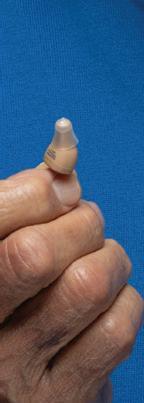
































Straddling the border of California and Nevada, Death Valley is one of the hottest and driest places on Earth. Unique geological features create the hot, dry climate, but life finds a way to thrive in the valley.
Rain shadows help prevent moisture from reaching Death Valley. When wet clouds over the Pacific Ocean travel east toward the valley, they must first pass over four mountain ranges. The clouds rise, making the moisture cool and condense, causing rain to fall. This successively happens, and an average of just 2 inches of rainfall a year lands on the valley.
Death Valley has low elevation— almost 300 feet below sea level— and is bowled in by mountains on all sides. When the desert floor heats up, the warm air rises but is trapped by the mountains and moves back to the valley floor. Despite this, winters in the valley can reach freezing temperatures, as the desert doesn’t retain heat as well as other biomes.
Death Valley can be great for a fall or winter road trip, when you won’t need to max out the air conditioner. Badwater Road is one of the most popular paths, takes about 90 minutes to drive and showcases the lowest point in the valley, as well as other viewpoints. Another popular spot is Zabriskie Point, a vista from which visitors can look over the badlands.
More Information
Death Valley is experiencing one of the hottest summers on record—it reached 127 F this July. Fall, winter and spring trips are much more popular. To start planning your trip, call 760-786-3200 or go online and visit www.nps.gov/deva.



























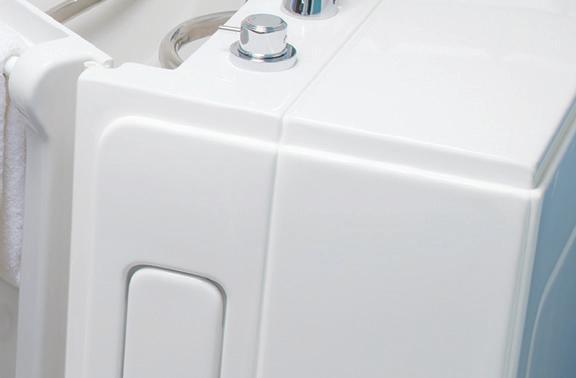


By Dave LaBelle
I remember photographing an elderly man leaning on a hoe while working in his garden. Watching him through a telephoto lens, I was curious what he was thinking. I may have asked him, but I don’t remember. Later, as I looked at the photograph, I wondered what his life had been like.
What were his dreams or regrets?
Then a year or so later, I was assigned to photograph a philosopher who was in town to speak. He was staying at a luxurious inn. Arriving early, as is my habit, I noticed a man walking slowly down a tree-lined driveway, his hands behind his back. Unnoticed, I stopped and
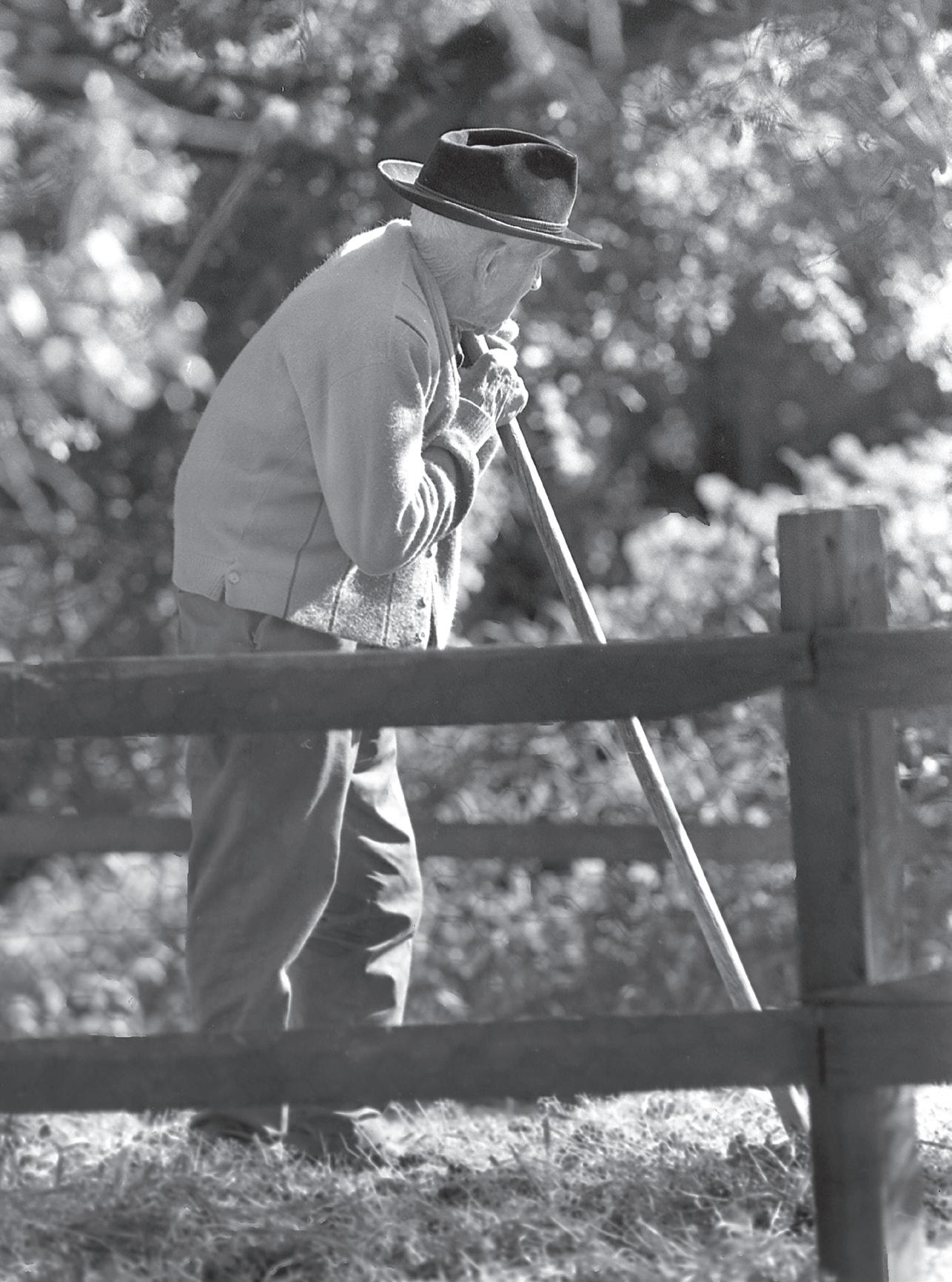
made a few photographs before approaching him.
I asked him about his morning stroll.
“I take long walks alone,” he answered. “I ask intelligent questions and get intelligent answers.” Then he added, “But my best thoughts usually come to me when I am on the toilet and have nothing else to do.”
Fifty-five years later, I see myself in the posture of both aging men. Either image could be a self-portrait of sorts, of me contemplating life now.
I have often seen glimpses of myself in others, for good and bad. In a quiet, subtle way, I think I have photographed others to express what I was experiencing. In telling their story, I was telling my own. Someone once wrote and said they had watched my daily newspaper photos for years and felt they knew me. I hadn’t thought much about that before, but reasoned there was some truth in their observation. No doubt those who follow this column or read my blog can say with some accuracy, they know me. The subjects I choose, the personal things I share— they are doors into my life and heart. I feel the same about some authors or sports announcers.
There was a period in my young life when I felt alone and hopeless. I photographed
Make a picture that expresses where you are in your life’s journey. Maybe it is something that reveals what you believe or how you see yourself? Or perhaps, like me, it’s something or someone you aspire to be like. This is a tough assignment but one worth trying.
Email your best image (just one, please) with caption information, including an explanation of how it affects you, to GPH@pur.coop. We may share submissions on our website and social media channels.
many sad and lonely people, transients and those who had lost loved ones. I think I was crying in my camera, silently asking for help through my photographs.
I believe most of us ask ourselves why we are here on this earth and what plan or purpose we serve. Now, at 73, I have come to realize one of the talents my creator has blessed me with is the gift to give others a voice while serving as a mirror to show others themselves, especially their beauty and value. n

Renowned author, photographer and lecturer Dave LaBelle has captured special moments for more than half a century. For more of his writings, visit davidlabelle.com and bridgesandangels.wordpress.com.






Praise for DiamondAura®
“So much sparkle and the play of light on DiamondAura® beats any diamond!” — D.D. from Columbus, OH


A classic tennis bracelet serves up over 10 carats of sparkle for a guaranteed win
It was the jewelry piece that made the world stop and take notice. In the middle of a long volley during the big American tennis tournament, the chic blonde athlete had to stop play because her delicate diamond bracelet had broken and she had to nd it. e tennis star recovered her beloved bracelet, but the world would never be the same.
From that moment on, the tennis bracelet has been on the lips and on the wrists of women in the know. Once called eternity bracelets, these bands of diamonds were known from then on as tennis bracelets, and remain the hot ticket item with jewelers.


with D Flawless diamonds from another company that costs $57,000!
Want to look like a million bucks without stressing over losing or damaging something that cost you a fortune? e Love Wins Tennis Bracelet is a simple strand of glittering gems in precious sterling that epitomizes elegance.

earrings with your purchase of the Love Wins Bracelet.

e rst time we o ered this bracelet, we sold out literally in minutes. It was our fastest selling product of 2021. It took six months to get it back in stock — Get yours before we run out!
And there’s more... we will also include our Ultimate Diamond Alternative™ DiamondAura® stud earrings for FREE!
Jewelry Speci cations:


We’ve captured this timeless classic with over 10 total carats of DiamondAura®, our signature diamond alternative stone. is sparkling marvel rivals even the nest diamonds (D Flawless) with its transparent color and clarity, and both are so hard they can cut glass. Don’t believe me? e book “Jewelry and Gems – e Buying Guide,” praised the technique used in our diamond alternative DiamondAura®: “ e best diamond simulation to date, and even some jewelers have mistaken these stones for mined diamonds,” it raved. For comparison, we found a similarly designed 10 carat tennis bracelet
• 10 ¾ ctw of the Ultimate Diamond Alternative®, DiamondAura®
• Rhodium- nished .925 sterling silver settings
• Bracelet: Fits wrists to 7 ½". Earrings: 1 ctw with post backs

Love Wins Tennis Bracelet (10 ¾ ctw) $399 $39* + S&P
FREE stud earrings (1 ctw) with your purchase of the Love Wins Bracelet — a $99 value!
*Special price only for customers using the offer code.

Your Offer Code: LWB296-02









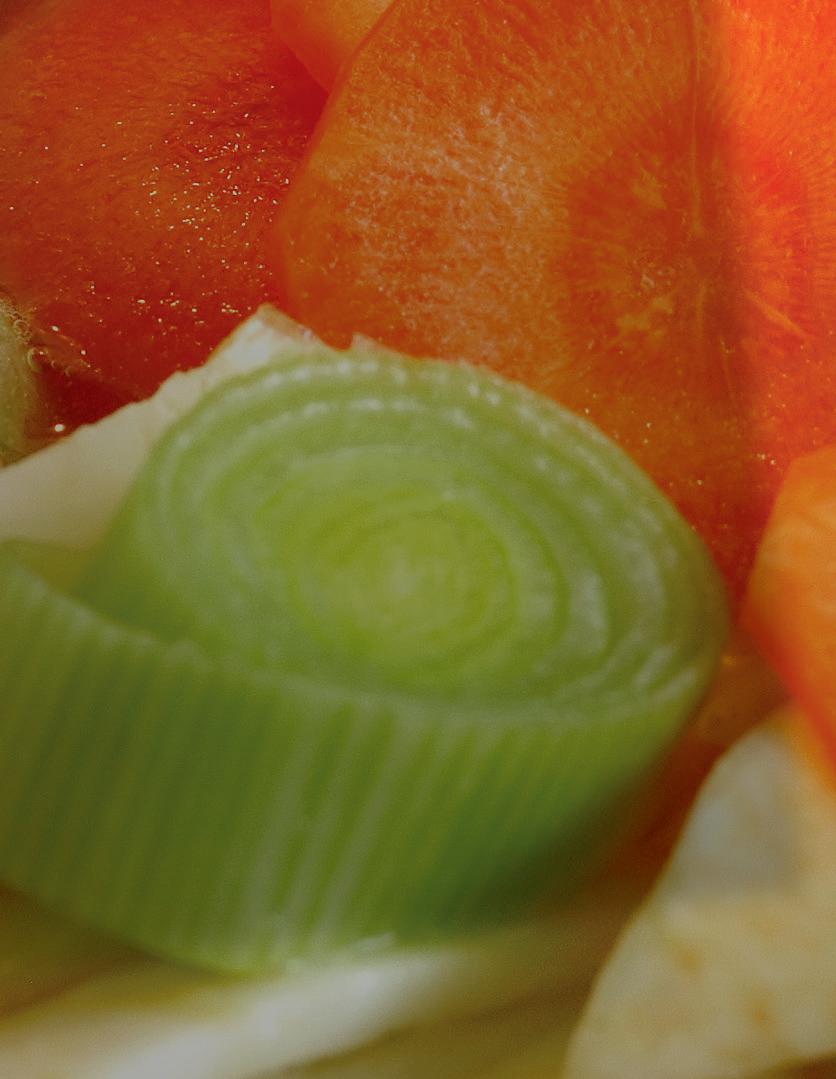




This book of more than 220 recipes from our 2005 contest has garden fresh and warm winter meals sure to appeal to every taste. Recipes include Lucious Pumpkin Soup, Nacogdoches Pheasant Stew and Smoked Salmon Chowder. The 8½-by-11-inch spiral-bound, indexed book is $8 (includes postage).

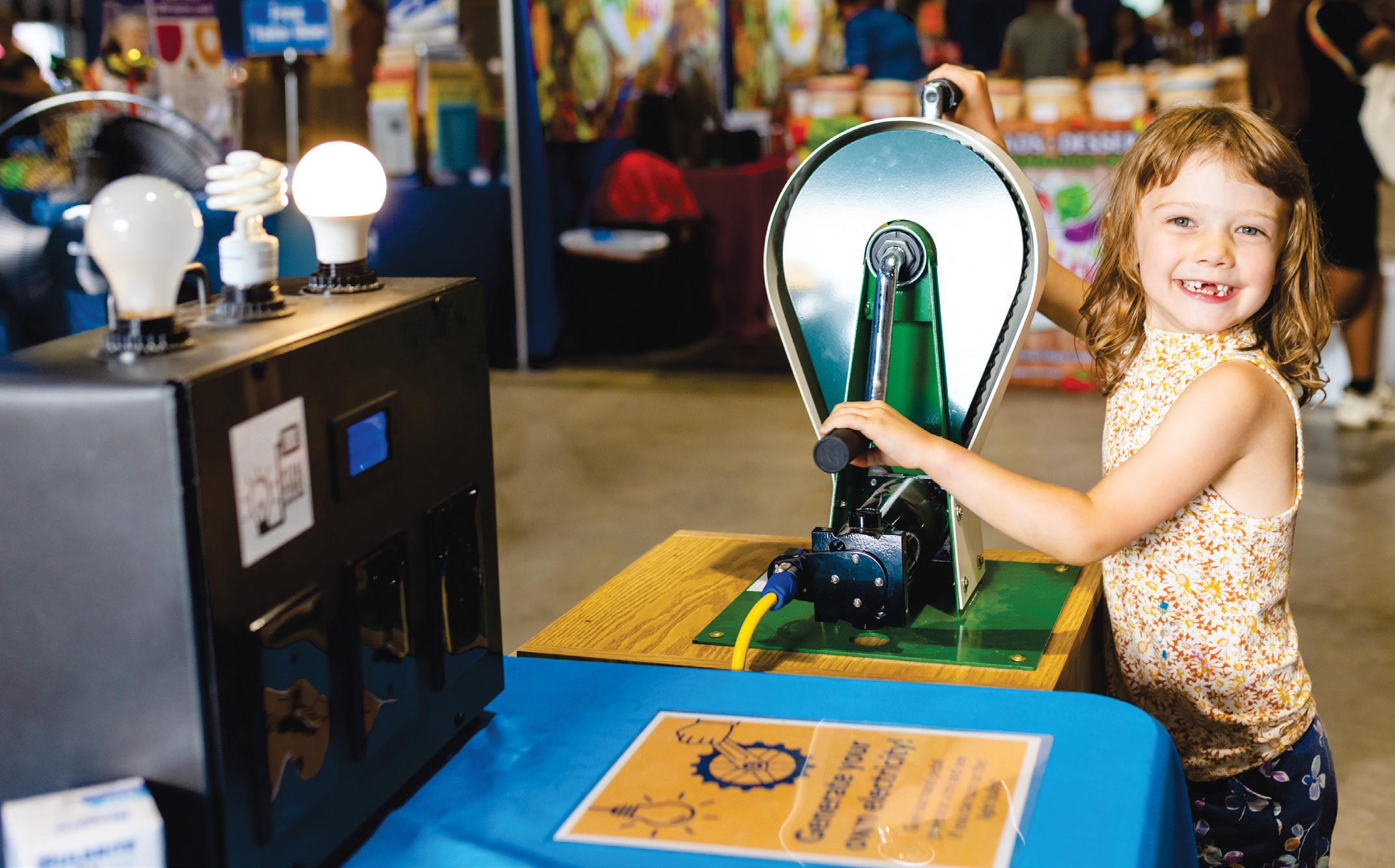



Golden Valley Electric Association had a great time spending time with members at the 2024 Tanana Valley State Fair, celebrating it’s 100th year. GVEA employees enjoy participating in this community event every year. Thank you to all the members who came to say hello, tested their knowledge with trivia, tried out the member-powered generator and played the ring toss game. Here’s to another century of fair fun and community spirit.
4x5 round bales, Meadow Foxtail Orchard Grass. 4x4 Timothy, small square. 208-435-4637 or 208-435-4002; nas@cpcinternet.com. 1224
Reinforced custom-sized pond liners (39 cents/sqft.). Hay covers, greenhouse covers, any width and length. Truck tarps and more. High puncture and tear strength. Best price guaranteed. Celebrating 43 years in business. www.btlliners.com. 541-447-0712.
2024 grass hay. 50 to 60 small square bales. Very good quality. 24760 Hwy. 101 South, Cloverdale. Call 503-812-2313 or 503-812-6539.
Buying antiques and collectibles: advertising signs, porcelain signs, gas pumps, beer signs, antique toys, cast-iron coin banks, neon signs and more. Jason, 503-310-3321 or tjabaughman@yahoo.com. 0924
Antique country store items. 1910-60. Tins, light-up signs, clocks, Coca-Cola, drugstore, soda fountain, barber items, beer sign and much more. Cash. Gregory, 208-301-4246. 0924
WC Collectibles. We buy comic books! Local to the Inland Northwest, willing to travel. WCCollectiblesCheney@gmail.com; 509-496-1835. 1024
Collection of ID license plates from 1920-40. 23 plates, 14 dates. Can text photo, $400 for all. 509-254-1947.
Mantle, Mays, Aaron, Koufax, etc. If interested in buying 1957-73 vintage baseball cards, let’s talk. Jim, 530-283-2826 or 530-394-8668.
Buying American Indian collectibles, Navajo blankets and rugs, baskets, beadwork, etc. Also, quality paintings of the early Southwest and Americas. Call 760-409-3117 or send photos to amer.ind.baskets@gmail.com. 1024
Rare 1960 Chevy pickup 4x4. Shortbed. Not running now. Text or call 661-713-3377. Leave message. $7K. 0824
Storage space for any RV, vehicle, boat and trailer. 24/7 security and access. Any size, $100 a month. Text Mark for call back, 714-949-6913. 0924
Books, Magazines, Videos
Book restoration. Bibles, cookbooks, cherished family heirlooms. Beautiful work. We give renewed life, more durable than original, to last for generations. 775-537-7066; salacanstudio@gmail.com. 0924AR
Ads 25 words or fewer are $35 a month. An extended ad of up to 35 words is $50 a month. Contact information is included in the word count. Phone numbers and emails count as one word.
Longer ads may be placed. Contact 503-357-2105 or info@pioneer.coop for pricing information.
Ads are for customers of member co-ops, public utility districts and municipals only. Subscribers and nonmembers may inquire about pricing at 503-357-2105 or info@pioneer.coop.
Ads must be direct and in first person, and are subject to approval and editing.
Closing deadlines (in our office): November issue—Sept. 30, 2024.
If submitting ad by mail, send appropriate payment with your name, address, email, phone number and the name of the electric utility that provides your magazine to: Marketplace, P.O. Box 1306, North Plains, OR 97133. Make check or money order payable to Ruralite.
We accept credit card payments for ads submitted by email. Send ad to info@pioneer.coop.
Call 503-357-2105 to pay by credit card.
Advertisements are accepted in good faith. Pioneer Utility Resources is not liable for interactions between buyers and sellers.
A great business opportunity in Boardman, OR. A small cafe you can use your imagination in. Frontage view of freeway, quick in and out access. A coffee shop on property for extra income. $1.1M. For more information, call Karen at 541-571-0636. 1024
Quaint hardware store in Maupin, OR, for sale. Inventory and interior store recently updated and refreshed. See ad on Bizbuysell.com or email Maupincountrystore@gmail.com. $259K. 0924
Community Events
“Start the Story at the End,” Sept. 6-Oct.26 and “Journeys & Convergence,” Sept. 6-28. Art Center East, La Grande, OR. artcentereast.org. 0924
Equipment/Tools
DR multi trimmer, $350. Kubota rototiller. Only 25 hours use. $1,150. 11 push-pull control cables $40-$90 each. FOB Eugene, OR. Ted, 458-910-3727. 1024
1965 Ford 3000 Tractor with auger/utility crane, rotary cutter, brush hog and box spreader. Runs. Original operator’s manuals. $4K, OBO. Cottage Grove, OR. 541-942-6837. 0924
Free Items
Free materials—church, government uniting, suppressing “religious liberty,” enforcing National Sunday Law. Be informed. Need mailing address only. TBS, P.O. Box 374, Ellijay, GA 30540. tbsmads@yahoo.com; 888-211-1715. 0924AR
Help Wanted
The Cape Blanco Heritage Society needs volunteers at the Cape Blanco Lighthouse Greeting Center and Hughes House for 2024 and 2025. Background checks are required. Free RV hookups are available to volunteers. heritage32@frontier.com; 541-332-0521. 1024
Hobbies, Gifts, Games
Selling United States postage stamp collection. Mint plate blocks and sheets dating back to the 1940s. Photo available. Bob, 541-786-6195 or brown.donna50@gmail.com.
Media
Watch Channel 25 (Southern NV)—on the go— for free on your TV, phone, tablet, computer or ROKU. Visit www.kpvm.tv and stream live today. 775-727-9400. 0924
Your ad could be here in November. See instructions above for details.
Miscellaneous
Granite cemetery markers at affordable prices. Will ship to most places. For more info: Joe, highdesertmemorials@gmail.com, 541-815-8906; www.highdesertmemorials.com. 1124
Local commercial fisherman sells summer catch of preserved freshness by blast freezing at sea, gourmet canned tuna on internet. Sept.June. 100% guaranteed the best canned tuna you ever tasted. Original, jalapeno and garlic flavors available. To order: twofisherstuna.com or call 206-799-1082. 1124
Alaskan Yellow Cedar. Great for planter boxes, herb and flower beds, fencing or decks. Various sizes available. Pete, 541-206-0727. Lisa, 541-747-5025, ext. 21. 1224
Pets, Supplies
AKC-registered Irish wolfhounds. Crane, OR. Morning Star Acres, www.morningstaracre.com. Barb, 541-589-2923.
Husky, male. 4 years old. Very gentle. Great with kids. Burntwood, OR. 541-875-4172.
AKC-registered Airedales. Fort Sage Kennels, Patricia Sharp, P.O. Box 246, Doyle, CA 96109. 530-827-2271. 0924
Plants, Garden Supplies
Cactus for sale. Cold/winter hardy. Good for landscaping. Sunnyside/Mabton, WA, area. Local pickup only. 509-391-5546; marybarthlow@gmail.com. 0924
Real Estate
15 off-grid acres at 8,400 ft. near Fort Garland, CO. Great view of CO’s fourth-highest peak. On Person’s Road in Sangre de Cristo Ranches. Piñon trees, year-round access. $52.9K. 541-729-0374. 0924
Buying or selling in Brookings, OR? Call Pat Piper at Century 21 Agate Realty first. Experience. Empathy. Education. Exceptional. 541-251-2152; patpiperbroker@gmail.com. 1024
Christmas Valley, OR. 40 acres with perimeter fence. 36x36 metal building, two carports, 370-ft. deep water well, storage container on chase. Only taking serious offers. 541-536-5776. 0924
Let me help you buy or sell ranch, farm and recreation property in OR. Fourthgeneration Oregonian, prior ranch owner. For sale: Sisters, OR. 40 acres. Price reduced. $1.55M. John Gill, 541-480-9161; johngill@ landandwildlife.com. Land and Wildlife brokerage. 0924
5-acre lots, $30K down and 5% interest. Recreational, beautiful view outside Cherry Creek, NV. Owner finance. Ray Bick, 775-591-0420. 0924
Beautiful custom home on 15 acres w/ stunning panoramic mountain and valley views. Garage, barn. $615K. Duke Warner Realty, 541-987-2363, ddwr@ortelco.net. 0924
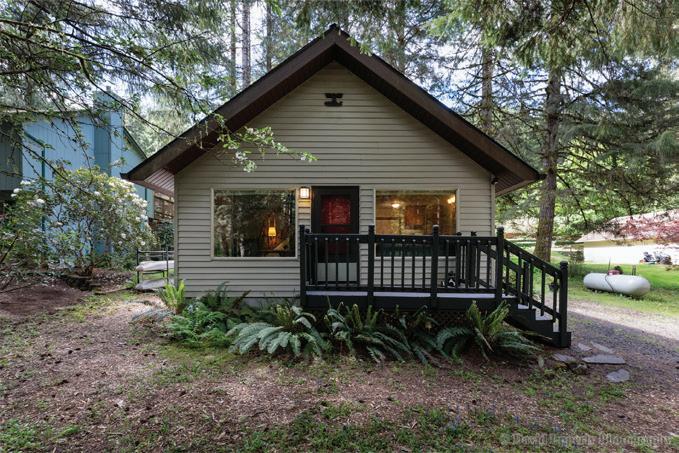
9956 Beach Drive, Birkenfeld, OR. Looking for a perfect getaway spot, or ever dreamed of living in the woods? Come see this adorable home at Fishhawk Lake. Tucked in the trees, you can relax by the firepit, swing in the hammock or wander to the lake for kayaking. Very open floor plan with primary bedroom and bathroom on the main level. Loft is a nonconforming second bedroom or maybe use as an office. Good storage, including the exterior shed. A quick jaunt to the community rec center, pickleball courts and more. So much to love and see here. Listed at $275K / ML#24220670 Listed by Lea Chitwood, Re/Max Power Pros. 503-730-4554/leachitwood@remax.net.
Irrigon, OR. 3-bd, 2-ba manufactured home on permanent foundation. Huge shop and garage stick-built, unattached. One full city block property. $400K/OBO. 541-922-9675. 0924
2-bd, 2-ba older home in Ely, NV, close to downtown businesses and events, all city utilities, many upgrades, detached garage on ¼-acre lot. 702-493-7581.
First home with 3 decks and second home with 2 decks, carport with 40-ft container, 2 sheds, tack building, mature shade and fruit trees on fenced 2.5 acres. White and Silver Peak mountains. $425K. 775-966-9009.
Recreational Rentals
Bend country cabin. Very clean and fully furnished cabin on private ranch. Close to recreation areas. Very nice. $95/night. 541-382-3050; bendcountrycabins@gmail.com.
Recreational Vehicles
Seeking an able-bodied, cheerful, retired individual or couple to help register guests and do fix-its around our small community motel and campground in exchange for apartment accommodations. Building community and ministry through hospitality here at Vantage Riverstone, Vantage, WA. Additional involvement opportunities via RV tenancy at affordable monthly rates. 509-8562800; Vantagedesk@gmail.com. RV rentals, as well as housing available.
Services
Dawn Till Dusk Masonry. Brick, block, stone and pavers. Small jobs and repairs welcome. Check out our website at dawntillduskconstructionmasonry.com. 541-388-7605; 541-410-6945. License #245760 bonded and insured. LaPine, OR. 0824
Timeshare victims? Call TimeShareBeGone, 800-214-4460. We will get your timeshare legally canceled. A+ BBB, five-star reviews, 16 years experience. 100% money-back guarantee.
We all want delicious, fresh, nourishing food to feed our families. We’ve got pastured pork, corn/soy/GMO-free. Delivery to your door or drop sites. Order at www.rural-roots-ranch.com or text Christy at 541-589-4674. 1224
Situations Wanted
Seeking an able-bodied, cheerful, retired individual or couple to help register guests and do fix-its around our small community motel and campground in exchange for apartment accommodations. Building community and ministry through hospitality here at Vantage Riverstone, Vantage, WA. Additional involvement opportunities via RV tenancy at affordable monthly rates. 509-856-2800; Vantagedesk@gmail.com.
Wanted: 1967-72 Buick Skylark, GS, Stage 1, GSX. Cars, parts or leads. Or any ’60s or ’70s vehicles. billybibbett@hotmail.com. 1124
Old carpenter tools, planes (wood/metal), levels, chisels, slicks, adzes, axes, hatchets, handsaws, old rulers, spoke shaves, wrenches, shipwright tools, old tool chests. 503-659-0009 or 971-666-0659. 0824
Gold, silver, coins/currency, buy, sell. Collections wanted. Fair prices paid. 44 years in retail store. Baker City, OR. 800-556-2133; garrymclin@aol.com. 1024
Buying American Indian collectibles, Navajo blankets and rugs, baskets, beadwork, etc. Also, quality paintings of the early Southwest and Americas. Call 760-409-3117 or send photos to amer.ind.baskets@gmail.com. 1024
Wanted: Old 501 Levi’s jeans, jackets w/capital “E” on the red tag. Also, Carhartts with red heart. Good prices. Text photos to 208-255-8030.
Private party looking for muscle car, V8, 2-door, manual transmission preferred. As original as possible, good condition. Willing to pay up for nice car. 1961-62 Chev (348/409), 1964-65 GTO, 1966-67 Nova, 1965-66 Chevelle, 1968-70 Charger/ Cuda. 1962-67 Corvette, 1969 Camaro. Call or text, 503-799-3835.
Eatonville United Methodist Church A Spiritual Base Camp On The Way To Paradise.
Mashell Avenue North P.O. Box 205 Eatonville, WA 98328 360-832-4021
Home: 360-832-4562 Pastor Bernard Preston Ritchea Cell: 361-330-9666
Facebook: Eatonville United Methodist Church of Washington OPEN HEARTS OPEN MINDS OPEN DOORS OPEN TABLE WORSHIP SERVICE BEGINS AT 10:30 a.m.

By Kris Capps
Not everyone is as serious about preserving food as Kathy Lake, who lives in a remote location off the Parks Highway north of Healy.
“I do it to feed my family nutritious food and to have a supply on hand when we can’t get out,” she says, recalling times bad weather kept her family homebound.
Plenty of other folks preserve food just as a hobby, even though they can easily drive to the grocery store anytime. All these people follow safety rules that ensure the preserved food is safe to eat.
Kathy Lake nurtures five greenhouses and a huge garden filled with vegetables, berries, herbs and fruit trees. She preserves “everything,” she says. “Fruits, vegetables, berries, mushrooms. We also have a freeze drier and right now, we’re doing a batch of tofu.
“Basically, anything you eat, you can prep and preserve,” she says.
Here are some of her suggestions for getting started.
“Start by looking at what your family eats,” she says. “Not everybody likes the same food. Then look at what you can do to make something yourself that you would normally have to purchase, especially from far away.
“Evaluate what your family will eat before you do anything. It doesn’t do any good to make something they’re not going to eat.”
Most people start with something simple, like jellies or jams made from berries they pick themselves locally.
The most common food preservation method used is water bath canning and it is especially useful to can foods with high acid content.
“Water bath canning is just a boiling pot of water,” she said. “Cans have to be below the water level by about two inches when the water is boiling. Most things take like 10 minutes in boiling water or up to 30 minutes.”
The amount of time varies. This is why it is important to have a good reference book on hand, or access to a reliable website. This reference guide will explain which foods can be preserved in this way. For example, green beans are preserved by pressure canning, unless they are pickled.
She cautioned against “rebel canning,” which involves older methods of preserving food. Some of those historic methods may not be safe.
There is a reason those methods changed over the years, she noted, saying “people used to die from botulinum toxin.”
Sickness or even death can result from improper food preservation. Kathy keeps two important reference books on hand. They offer specific instruction on how to preserve different foods in different ways.
“A pressure canner is not the same as a pressure cooker,” she points out.
These reference books are available at the public library.
“You don’t have to spend a lot of money, but if you’re going to be doing a lot of it, you’ll want to have that reference on hand at home,” she says. “If you are just trying to learn how to do something, start with the library and see if you can do it and if you like doing it.”
Kathy actively preserves food five different ways: water bathing, pressure canning, dehydrating, freeze drying and freezing.
“Freezing is the easiest if you have freezer space,” she says.
Dehydrating is also easy for some foods and the price tag for a dehydrator is reasonable.
“It’s pretty simple,” she says. “You just place the items in the dehydrator, push the button for the type of food, leave it, then check back later.”
Water bath canning is a little more complicated, so she suggests starting with jams, jellies and pickles.
Pressure canning is the next step of food preservation. It’s also more of an investment as a good pressure canner can cost a couple hundred dollars. This method can preserve low acid foods, meats, salmon and more.

“Always by the book,” Kathy says.
Freeze drying is another method that is somewhat expensive. This removes water from the food.
“You can freeze dry almost anything,” she says. “Properly stored with mylar and oxygen absorbers, it can last 30 years. It won’t spoil.”
This is the kind of preservation used in those packets of food for backpackers. Oxygenation is what spoils food, so commercially purchased oxygen absorbers prevent the process from happening.
All this food preservation takes time and some dedication to research procedures and follow through properly. But it can be worth it.
“When COVID hit, we didn’t have to go anywhere for anything,” Kathy recalls. “A lot of people were struggling because they had a week’s supply of groceries.”

Her family keeps about a one year supply of food on hand. If, for some reason, her family couldn’t leave the house for an entire winter, it would not be fun. But they would not have to worry about food.
She doesn’t think what she does is that unusual.
“I guess the more remote you get, the less unusual it is,” she says.
“We are prepared by necessity. You go to a city and you’ll find people who go shopping on a daily basis.
Their needs are not my needs,” she notes. n
City cat, meet country fawn.
When Kim Kauzlarich and her family moved from Portland to White Salmon, Washington, it was an adjustment for the whole family. But Ragnar the cat might have had to endure the biggest change given the wildlife visiting their backyard.
“Both deer and the cat seem to enjoy peacefully watching each other,” Kim says. “Fawns are especially curious about Ragnar and want to play, but being the busy guy that he is, he only has time for a quick meet and greet before moving on with his day.”
To submit your photo, email a JPEG file to photos@pioneer.coop. Include “Before You Go” in the subject line. Please share a bit about what inspired you to make your photo. n
Vegetable Casserole, Pork Tamale Casserole and breakfast casseroles are just a few of the 179 mouth-watering recipes available in Ruralite’s Casseroles booklet. Price is $8, shipping included.
To order by mail, submit with proper payment, cookbook title, your name, address and number of cookbooks wanted to Ruralite Cookbooks, P.O. Box 1306, North Plains, OR 97133.
To pay with Visa, MasterCard, Discover card or American Express, call 503-357-2105.
To order online, visit www. ruralite.com.

Allow 2-3 weeks for delivery.









































Owned By Those We Serve
Tom DeLong, Chair, District 2
Chris Bunch, Vice Chair, District 5
David Messier, Treasurer, District 1
Gary Newman, Secretary, District 4
Fred Sheen, District 6
Rick Solie, District 3
Krista Zappone, District 7
Corporate Headquarters
758 Illinois St. P.O. Box 71249
Fairbanks, AK 99707-1249
907-452-1151
800-770-GVEA (4832) Fax 907-458-6365
Delta Junction Office 1681 Richardson Highway Delta Junction, AK 99737
907-452-1151
800-770-GVEA (4832) Fax 907-895-5472
Report Outages:
907-452-1151
800-770-GVEA (4832)
Select: Option 1, Option 1
View Outage Map: gvea.com/outages
www.gvea.com
AK-37
Next spring, members in GVEA Districts 5 and 6 will elect their board representatives. Nominating committees for these districts are now forming. Members meet several times between November and February.
Get Involved. The application deadline is 5 p.m. Wednesday, October 9.
District 5
Includes the general area of North Pole; the Richardson Hwy. from Mile 352 and the east side of Woll Rd; Nordale Rd; the area north of Chena Slough, excluding the general area of Chena Hot Springs Rd; Moose Creek; Eielson; and south to the Salcha River.
District 6
Includes Delta Junction, Fort Greely and all areas south of the Salcha River, including Harding and Birch Lakes.
Applications can be found at www.gvea.com/elections.
If you have questions, call 907-458-4518, or email pr@gvea.com.
Maps of each district are available at www.gvea.com/elections.